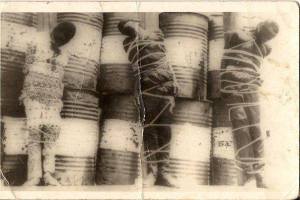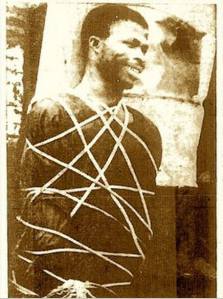SANGO; The god of Thunder
Sango;
the god of thunder is believe to be great deity as he was a great man
while he was alive. The Yoruba people around the world share the belief
that Sango often known as Xango or Chango by the Carribeans and the
Latin Americans is also known as Jakuta (the
thrower of stones or the thrower of thunderbolt-Edun Ara) . he is known
as the center point of Lukumi (Olukumi which means my dear one)
religion of the Carribeans. Many initiation ceremonies as performed in
Cuba, Puerto Rico and Venezuela for hundreds of years past are based on
the traditional Sango ceremony of the ancient Oyo.
Sango has carved for himself histories among different people around the world.- Basically they are all Yoruba.
History of Sango as told by the Yoruba of West Africa.
Sango
was the third Alaafin of Oyo. He was the second son of Oranmiyan; the
founder of Oyo Empire; the youngest of the grandsons of Oduduwa. Sango
was a brave and powerful man that inherited most of his special
abilities from the Nupe, his mother’s people. During the reign of
Alaafin Ajaka, Oyo Empire was under a regular treat of war from Olowu,
Ajaka’s cousin; who rules Owu Kingdom. Olowu later sent his warriors to
capture Alaafin Ajaka and bring him to Owu. In their bid to rescue
Alaafin Ajaka, the Oyomesi (Oyo’s council of chiefs), sent for Sango in
Nupeland where he had lived. He rescue to Ajaka and he was crowned King
while Alaafin Ajaka was sent into exile.
Sango,
in his lifetime, had three wives: Oba, the first wife and in the
traditional sense the legitimate, Oshun, the second and Oya, the third, a
concubine (as no marriage right or dowry was paid on her) was a spirit
who has the power to transform from human to animal. She also has the
power to summon rain. Together with Sango’s thunderbolt, they had
terrific victories in battle. The resulting Jealousy by Oba and Oshun
makes Oya to be more close to Sango- becoming his princess consort (Ayo)
and having access to Sango’s thunderbolt (Edun Ara) which later bring
about his doom.
During
the reign of Sango, he had two generals: Timi Agbale Olofa-ina (also
known as Olu-ode) who could shoot arrows of fire and Gbonka (also Known
as Eliri) who was equally powerful. After disobeying his direct order
not to match on Owu in Battle, Sango follows Oya’s advice to get rid of
them and sent them to govern the border towns of the Empire. Timi obeyed
him and left for Ede but Gbonka stayed back in Oyo to pose further
treat. Sango in his quest to destroy them both: sent Gbonka to Ede to
capture Timi which he did. Sango who believed that the match in Ede was
staged asked for a re-match in Oyo and Gbonka defeated Timi. Sango then
ordered that Gbonka should be burn to ashes. Mysteriously, he appeared
after three days giving Sango ultimatum to vacate the throne for his
infidelity. Sango angrily request for his Edun-Ara from Oya that has
being in the possession of it. He found it to be wet and stained with
blood from her period.
He
left the palace to a high rock facing the palace to re-affirm the
potency of his thunderbolt. The thunder he created stroke the palace and
burnt it down. Oba and Oshun; after losing everything to the inferno,
left the palace angrily blaming one another for allowing Oya such access
to Sango and became the undergoddess of the river Oba and Oshun
respectively. (both in Osun state Nigeria). Oya, on her part, went back
to the forest in Nupeland where Sango found him and became the
undergoddess of Odo- Oya(now known as river Niger)
Historical corrections
Sango;
heartbroken; left the town followed by the chiefs and members of his
royal cult known as Baba-Mogba persuading him not to leave. After an
unyielding persuasion, the chiefs went back as they approach an Ayan
tree in a place called koso with the news that the king has hanged. But
that is not true. Only a few of the Baba-Mogba who did not go back knew
the truth which is:
Sango
was attacked by Gbonka but Sango unwilling to fight varnished into thin
air only to appear in the sky to destroy Gbonka and those peddling the
rumors that he hanged. – Hence the popular saying OBAKOSO OR OLUKOSO
meaning the king did not hang. –As created by the Baba-Mogba who knew
the truth.
History of Sango in the Carribeans and Latin America.
Sango (or Jakuta) was the third Alaafin (king) of Oyo.
The
king is a major character in the divination literature of the Lukumi
religion. Stories about Sango's life exemplify some major themes
regarding the nature of character and destiny. In one set of stories,
Sango is the son of Aganju and Obatala
when in female form. As the story goes, Obatala, the king of the white
cloth was travelling and had to cross a river. Aganju, the ferryman and
Undergod of fire, refused him passage. Obatala retreated and turned
himself into a beautiful woman. He returned to the river and traded
his/her body for passage. Sango was the result of this unusual union.
The tension between reason represented by Obatala and fire represented
by Aganju would form the foundation of Sango's particular character and
nature. In further stories of the faith, we find that Sango goes in
search of Aganju, his father, and the two of them play out a drama of
conflict and resolution that culminates with Sango throwing himself into
the fire to prove his lineage. All of the stories regarding Sango tend
to revolve around dramatic events such as this one. He has three wives;
his favorite (because of her excellent cooking) is Oshun, a river Undergoddess. His other wife, Oba,
another river spirit, was conned by Oshun into offering their husband
her ear to eat. His anger was greatly kindled by this, and she is said
to have fled from his presence to subsequently become the Oba River,
which merges with the Oshun River
to form dangerous rapids that are believed to be the physical
manifestation of her life-long hatred for her fellow royal consort.
Lastly, Oya
was Sango’s third wife, and was the one out of the three who managed to
learn the secrets of his special powers to use in later life.
Veneration of Sango
The
religious ritual of Sango was possibly designed in order to help the
devotees of Sango gain self-control. Historically, Sango brought
prosperity to the Oyo Empire during his reign. After his deification,
the initiation ceremony of the cult of his memory dictates that this
same prosperity be bestowed upon followers, on a personal level.
According to Yoruba and Vodou belief systems, Sango hurls bolts of
lightning at the people chosen to be his followers, leaving behind
imprints of stone axe blades on the Earth's crust. These blades can be
seen easily after heavy rains. Veneration of Sango enables—according to
Yoruba belief—a great deal of power and self-control.
Sango
altars often contain an often-seen carved figure of a woman holding her
bosom as a gift to the god with a single double-blade axe sticking up
from her head. The axe symbolizes that this devotee is possessed by
Sango. The woman's expression is calm and cool, expressing the qualities
she has gained through her faith.
Veneration in different cultures
Sango is venerated in Haitian Vodou, as a god of thunder and weather; in Brazilian Candomblé Ketu (under the name Xango); in Umbanda, as the very powerful loa Nago Sango; in Trinidad as Sango God of Thunder, drumming and dance ; and in Cuba, Puerto Rico and Venezuela - the Santeria equivalent of St Barbara, a traditional colonial disguise for the Deity known as Chango.
In art, Sango is depicted with a double-axe on his three heads. He is associated with the holy animal, the ram, and the holy colors of red and white.





































